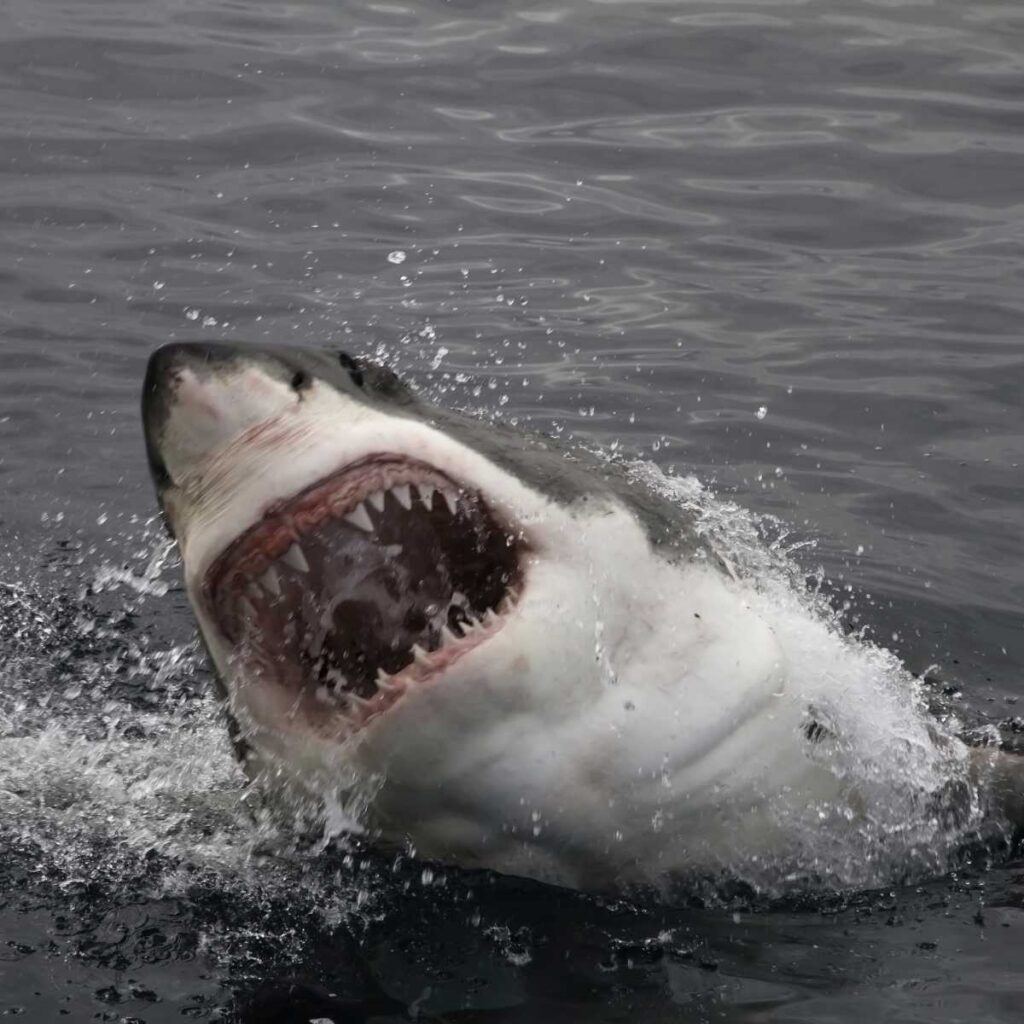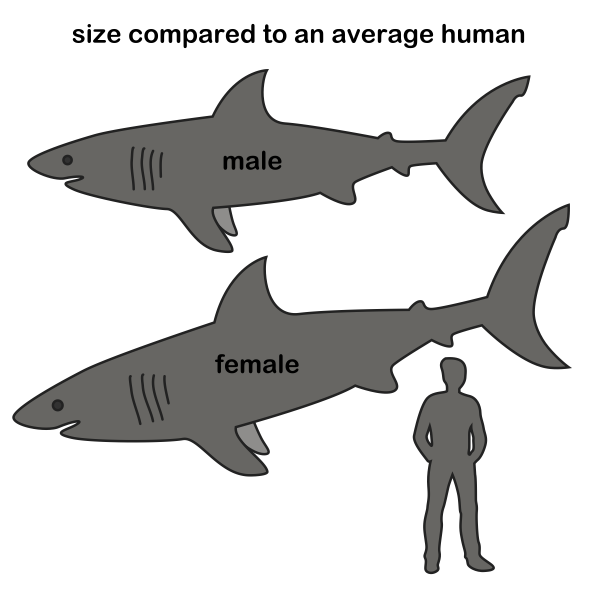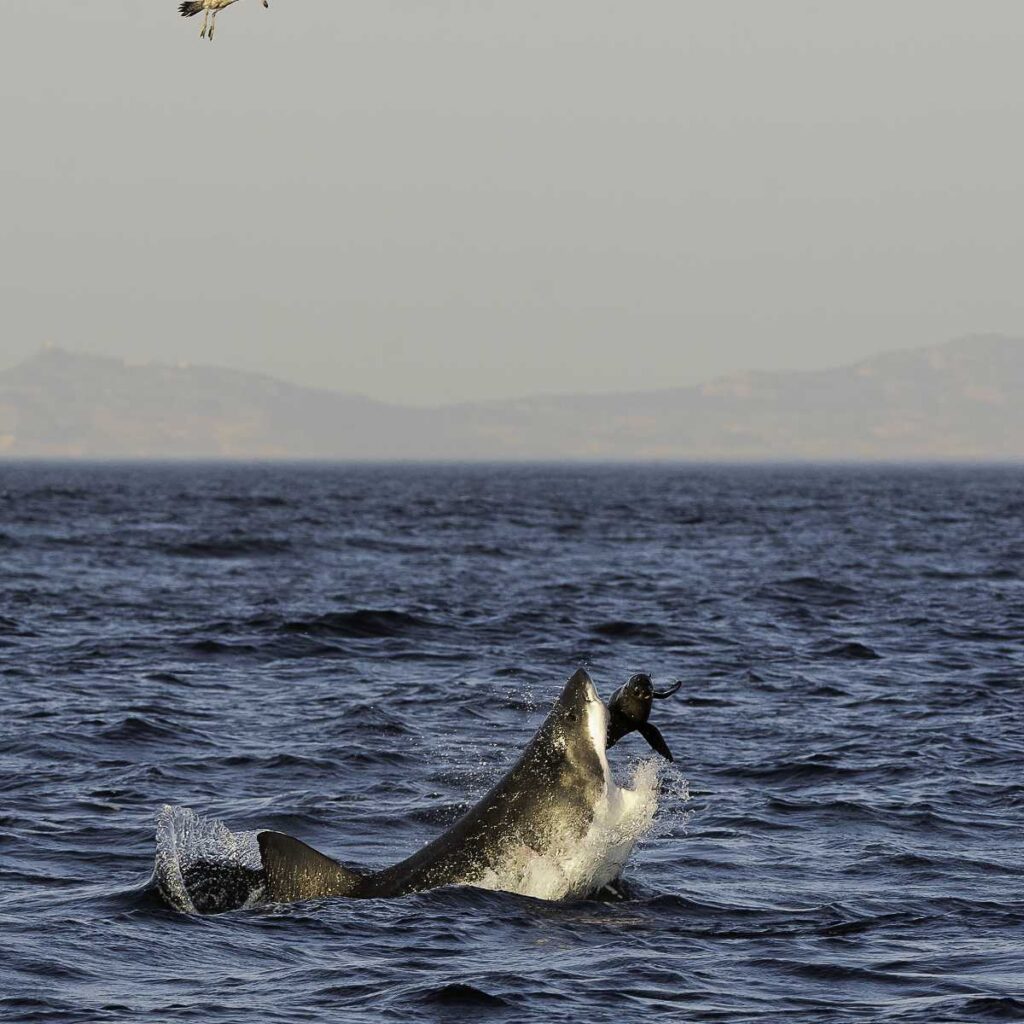Last Reviewed and Updated on March 15, 2023
Great white sharks, also known as simply white sharks, are one of the most well-known and feared shark species. There are many fascinating facts about great white sharks worth knowing, from the fact they aren’t cold-blooded to their high intelligence.

About Great White Sharks
The great white shark (Carcharodon carcharias), also known as the white shark, white pointer, or great shark, is found in coastal waters around the world. They live in waters with temperatures between 54 and 75 degrees Fahrenheit / 12 and 24 °C.
White sharks are large, predatory fish that can grow up to impressive sizes, males usually to about 11 to 13 ft / 3.4 to 4.0 m and females to about 15 to 16 ft / 4.6 to 4.9 m on average. They have a distinctive, torpedo-shaped body and are gray, blue, or brown on the top with a white underside. Their mouths are filled with several rows of sharp teeth. Recent research suggests they live over 70 years on average.
They are apex predators, meaning they are at the top of the food chain. Their diet consists of a variety of fish (other sharks included), squid, and marine mammals such as seals, sea lions, dolphins, and seabirds.
Great white sharks have a slow reproductive rate, with females not reaching sexual maturity until they are (likely) around 26 years old. They give birth to live young and typically have litters of 2-12 baby sharks. The gestation period is around 11 months.
White sharks are classified as vulnerable by the International Union for Conservation of Nature (IUCN). Their exact numbers are unknown. They are threatened by overfishing as a game animals and accidental capture in fishing gear.

Great White Shark (Carcharodon carcharias)
Size: males are about 11 to 13 ft / 3.4 to 4.0 m an females to about 15 to 16 ft / 4.6 to 4.9 m in lenght
Weight: on average 1,151–1,700 lb / 522–771 kg, females can be even heavier
Color: gray, blue or brown on top with a white underside
Diet: carnivore
Lifespan: estimated to be over 70 years
Habitat: coastal saltwaters around the world
Interesting facts about great white sharks
What is special about the white shark? How are they unique in the world of fish? Read these fun facts about great white sharks and find out.

1. Great white shark is the biggest predatory fish in the world
Out of all fish in the sea, the great white shark is the largest predatory fish on average. A single larger-than-average Greenland shark or tiger shark, for example, can be larger than a small white shark but generally are not.
White sharks are also one of the largest shark species in the world, with only the plankton-eating whale sharks, basking sharks, and megamouth sharks being larger.
2. They are (semi) warm-blooded
Animals are generally either warm-blooded or cold-blooded, with most fish being cold-blooded. But the line between these two isn’t always clear. There is also an “in-between” category of regional endotherms, where a specific part or parts of the body have a higher temperature than the ambient temperature (water temperature in the case of a shark). The temperature of the stomach of a great white shark was measured to be well above (almost 15 degrees) the temperature of the surrounding water (source). Their internal temperature, in general, is warmer than the water around them, and they are able to regulate it to some extent, but only in parts of their body.
So while not fully warm-blooded like mammals, they are considered endotherms (warm-blooded), poikilotherms (animals whose internal temperature varies), or mesotherm (between cold-blooded and warm-blooded).
3. They display countershading
Countershading is a type of camouflage that is common among many marine animals, including these fierce sharks. Countershading is a form of coloration that helps animals to blend into their environment and avoid detection both by predators and prey.
Animals with countershading have a dark-colored upper body and a lighter-colored underside. When viewed from above, the dark upper body blends in with the dark ocean floor, making it harder for predators or prey to see the shark from above, and when viewed from below, the lighter-colored underside blends in with the brighter surface waters.
4. Great white sharks are apex predators but do have a predator or two
Great white sharks are apex predators, meaning they are at the top of the food chain and have few natural predators. Even if you are on the top of the food chain, you can’t live a peaceful life as there is always a bigger fish or a mammal in the ocean.
Killer whales are known to hunt white sharks; they form hunting groups that can overwhelm and kill a great white shark. A single killer whale has been known to kill the shark too, turning it upside down and drowning it.
White sharks can also be cannibalistic, so a larger great white shark may hunt down a smaller one.
5. Great white sharks need to swim to not drown
Great white sharks are obligate ram ventilators, which means that they need to keep swimming in order to breathe. As water passes over their gills, it provides oxygen to their blood. If a great white shark would stop swimming, it would no longer be able to move water over its gills, and it would suffocate and die. They can’t afford to be still for more than just short periods of time.
6. Their eyes are large compared to most sharks
Great white sharks have relatively large eyes compared to other shark species.
Fun fact: a shark’s eye has a layer of reflective cells in its eyes (like cats) that allows them to better see in the dark and makes the eyes appear as if they glow in the dark.
7. White sharks stay buoyant with their fatty livers
Unlike most fish, sharks don’t have swim bladders. Instead, they control their buoyancy with their livers which contain large amounts of oil.
8. White sharks have an excellent sense of smell
Out of all of their senses, their sense of smell is the most developed. Their olfactory bulb (tissue involved in the sense of smell) might be the largest of any shark. They can smell even the faintest amount of blood from hundreds of feet/meters away.
9. Largest confirmed and preserved shark measured 19.1 ft / 5.83 m in length
The largest confirmed and preserved specimen is a female shark that measures 19.1 ft / 5.83 m in length in the Museum of Zoology in Lausanne.
The largest reported and confirmed was 20 ft / 6.1 m in length, a female caught in 1988.
There are numerous unconfirmed and unverified reports of sharks far exceeding these lengths.
10. They can sense electromagnetic fields
White sharks have electroreceptors that detect the electrical fields produced by living organisms. This helps them locate prey even in murky water or low-light conditions. These receptors are in the shark’s snout.
11. They have one of the strongest bite forces of all animals
A computer simulation was made to estimate their bite force, and unsurprisingly it was determined that great whites have one of the strongest bites in the animal kingdom (source study).
12. Their 300 teeth are ever replacing
Great white shark teeth are constantly growing, and they are replaced throughout the shark’s lifetime. When a tooth is lost, a new one will move forward to take its place from a row of replacement teeth located behind the functional teeth. This process allows great white sharks to have a virtually endless supply of teeth.
13. Great white sharks are one of the rare sharks that like to take a peek out of the water
They regularly lift their heads out of the water, a behavior not usually seen in sharks. They do this in order to gaze at prey and other objects. This behavior is known as spy hopping.
14. They are solitary but can form clans
These sharks are usually solitary but are known to form clans. These clans have been observed at Seal Island, where the sharks have been swimming in and out in stable groups of two to six members each year.
15. Great white sharks can breach

They regularly jump out of the water. This is partially a hunting technique used by great white sharks to surprise and stun their prey, especially seals and birds.
16. They are responsible for most unprovoked shark bite incidents
While shark attacks are still relatively rare, great white sharks are one of the more aggressive species and are responsible for most unprovoked shark bite incidents.
17. Great white shark doesn’t like the taste of humans, probably
It is likely they don’t like the taste of human flesh, and this might be the reason why most attacks are just bites and not people becoming shark dinners. Once they take a bite, they might not like the taste.
But that might not be the case. Usually, these sharks bite and stun their prey before delivering the final blow. Unlike most of their prey, humans have the tendency to run away, which messes up the shark’s plans.
18. They sank a few boats
When they breach, they can accidentally land on a boat. This might lead to the boat sinking. They may attack boats occasionally as well, and inflatable ones don’t always bode well in these situations.
19. They are considered very intelligent

Many of the facts about great white sharks listed before this one already hinted at their intelligence. But here are a few more examples.
These sharks learn from experience; they hone their skills as they grow and rely more on thought-through strategy than quickly biting.
They know just how to attack a specific species of animal to get the best results. They attack dolphins from above, behind, or below to avoid their echolocation.
Great white sharks exhibit curiosity.
Self-perseverance is at top of their list. When a shark is killed (by a killer whale, for example), the whole population of sharks, dozens of them, have been observed to migrate away from the area and not return.
20. They may be able to change color
A study completed in 2022 suggests great white sharks may be able to change their color to some extent and better camouflage themselves in order to be even more efficient hunters (article).
